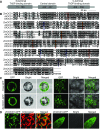Maize Oxalyl-CoA Decarboxylase1 Degrades Oxalate and Affects the Seed Metabolome and Nutritional Quality
- PMID: 30201823
- PMCID: PMC6241262
- DOI: 10.1105/tpc.18.00266
Maize Oxalyl-CoA Decarboxylase1 Degrades Oxalate and Affects the Seed Metabolome and Nutritional Quality
Abstract
The organic acid oxalate occurs in microbes, animals, and plants; however, excessive oxalate accumulation in vivo is toxic to cell growth and decreases the nutritional quality of certain vegetables. However, the enzymes and functions required for oxalate degradation in plants remain largely unknown. Here, we report the cloning of a maize (Zea mays) opaque endosperm mutant that encodes oxalyl-CoA decarboxylase1 (EC4.1.1.8; OCD1). Ocd1 is generally expressed and is specifically induced by oxalate. The ocd1 mutant seeds contain a significantly higher level of oxalate than the wild type, indicating that the ocd1 mutants have a defect in oxalate catabolism. The maize classic mutant opaque7 (o7) was initially cloned for its high lysine trait, although the gene function was not understood until its homolog in Arabidopsis thaliana was found to encode an oxalyl-CoA synthetase (EC 6.2.1.8), which ligates oxalate and CoA to form oxalyl-CoA. Our enzymatic analysis showed that ZmOCD1 catalyzes oxalyl-CoA, the product of O7, into formyl-CoA and CO2 for degradation. Mutations in ocd1 caused dramatic alterations in the metabolome in the endosperm. Our findings demonstrate that ZmOCD1 acts downstream of O7 in oxalate degradation and affects endosperm development, the metabolome, and nutritional quality in maize seeds.
© 2018 American Society of Plant Biologists. All rights reserved.
Figures









Comment in
-
Nutritious corn.Nat Plants. 2018 Oct;4(10):741. doi: 10.1038/s41477-018-0281-z. Nat Plants. 2018. PMID: 30287956 No abstract available.
Similar articles
-
An Arabidopsis Oxalyl-CoA Decarboxylase, AtOXC, Is Important for Oxalate Catabolism in Plants.Int J Mol Sci. 2021 Mar 23;22(6):3266. doi: 10.3390/ijms22063266. Int J Mol Sci. 2021. PMID: 33806862 Free PMC article.
-
Opaque7 encodes an acyl-activating enzyme-like protein that affects storage protein synthesis in maize endosperm.Genetics. 2011 Dec;189(4):1281-95. doi: 10.1534/genetics.111.133967. Epub 2011 Sep 27. Genetics. 2011. Retraction in: Genetics. 2023 Mar 2;223(3):iyac174. doi: 10.1093/genetics/iyac174. PMID: 21954158 Free PMC article. Retracted.
-
Genome editing of an oxalyl-CoA synthetase gene in Lathyrus sativus reveals its role in oxalate metabolism.Plant Cell Rep. 2024 Nov 13;43(12):280. doi: 10.1007/s00299-024-03368-8. Plant Cell Rep. 2024. PMID: 39538000
-
Maize opaque mutants are no longer so opaque.Plant Reprod. 2018 Sep;31(3):319-326. doi: 10.1007/s00497-018-0344-3. Epub 2018 Jul 5. Plant Reprod. 2018. PMID: 29978299 Free PMC article. Review.
-
The regulation of zein biosynthesis in maize endosperm.Theor Appl Genet. 2020 May;133(5):1443-1453. doi: 10.1007/s00122-019-03520-z. Epub 2020 Jan 2. Theor Appl Genet. 2020. PMID: 31897513 Review.
Cited by
-
A Systemic Investigation of Genetic Architecture and Gene Resources Controlling Kernel Size-Related Traits in Maize.Int J Mol Sci. 2023 Jan 5;24(2):1025. doi: 10.3390/ijms24021025. Int J Mol Sci. 2023. PMID: 36674545 Free PMC article.
-
Maize RNA 3'-terminal phosphate cyclase-like protein promotes 18S pre-rRNA cleavage and is important for kernel development.Plant Cell. 2022 Apr 26;34(5):1957-1979. doi: 10.1093/plcell/koac052. Plant Cell. 2022. PMID: 35167702 Free PMC article.
-
Riboflavin integrates cellular energetics and cell cycle to regulate maize seed development.Plant Biotechnol J. 2022 Aug;20(8):1487-1501. doi: 10.1111/pbi.13826. Epub 2022 Apr 29. Plant Biotechnol J. 2022. PMID: 35426230 Free PMC article.
-
Nitrogen reduces calcium availability by promoting oxalate biosynthesis in apple leaves.Hortic Res. 2024 Jul 30;11(10):uhae208. doi: 10.1093/hr/uhae208. eCollection 2024 Oct. Hortic Res. 2024. PMID: 39372287 Free PMC article.
-
The Peroxisomal-CoA Synthetase MoPcs60 Is Important for Fatty Acid Metabolism and Infectious Growth of the Rice Blast Fungus.Front Plant Sci. 2022 Jan 26;12:811041. doi: 10.3389/fpls.2021.811041. eCollection 2021. Front Plant Sci. 2022. PMID: 35154208 Free PMC article.
References
-
- Bateman D.F., Beer S.V. (1965). Simultaneous production and synergistic action of oxalic acid and polygalacturonase during pathogenesis by Sclerotium rolfsii. Phytopathology 55: 204–211. - PubMed
-
- Berthold C.L., Moussatche P., Richards N.G., Lindqvist Y. (2005). Structural basis for activation of the thiamin diphosphate-dependent enzyme oxalyl-CoA decarboxylase by adenosine diphosphate. J. Biol. Chem. 280: 41645–41654. - PubMed
-
- Brzezicha-Cirocka J., Grembecka M., Szefer P. (2016). Oxalate, magnesium and calcium content in selected kinds of tea: impact on human health. Eur. Food Res. Technol. 242: 383–389.
-
- Casteels M., Sniekers M., Fraccascia P., Mannaerts G.P., Van Veldhoven P.P. (2007). The role of 2-hydroxyacyl-CoA lyase, a thiamin pyrophosphate-dependent enzyme, in the peroxisomal metabolism of 3-methyl-branched fatty acids and 2-hydroxy straight-chain fatty acids. Biochem. Soc. Trans. 35: 876–880. - PubMed
Publication types
MeSH terms
Substances
LinkOut - more resources
Full Text Sources
Other Literature Sources
Research Materials

